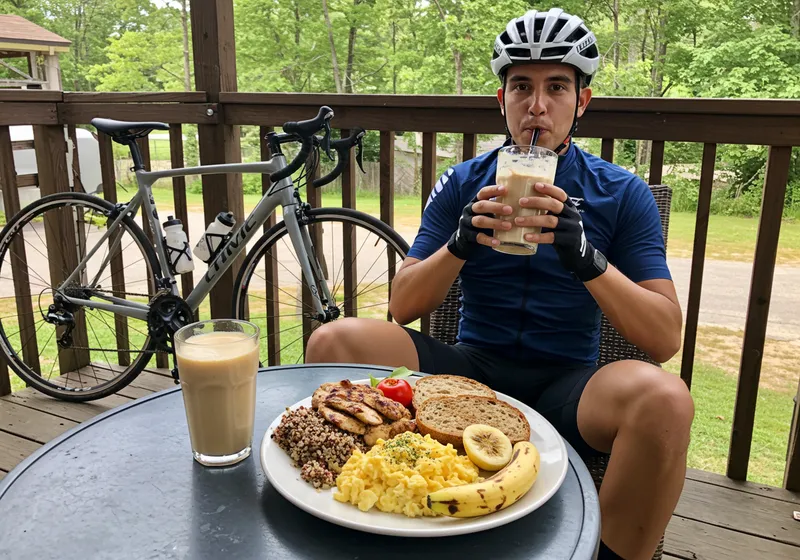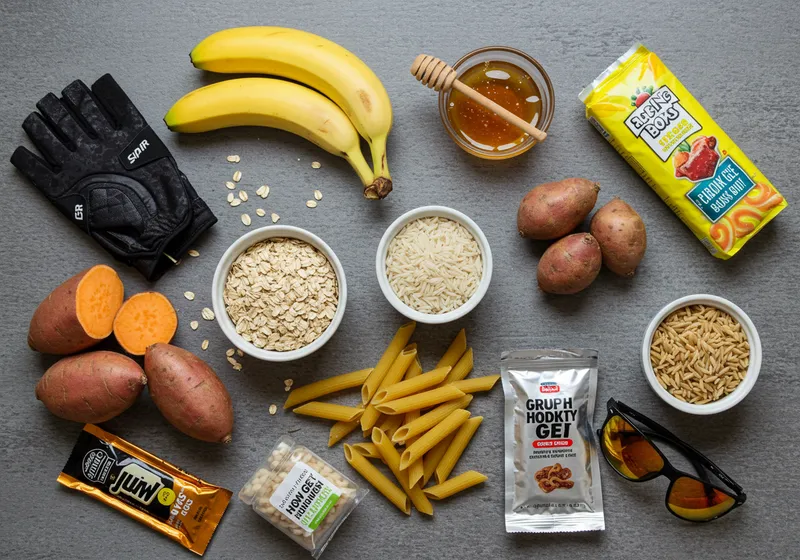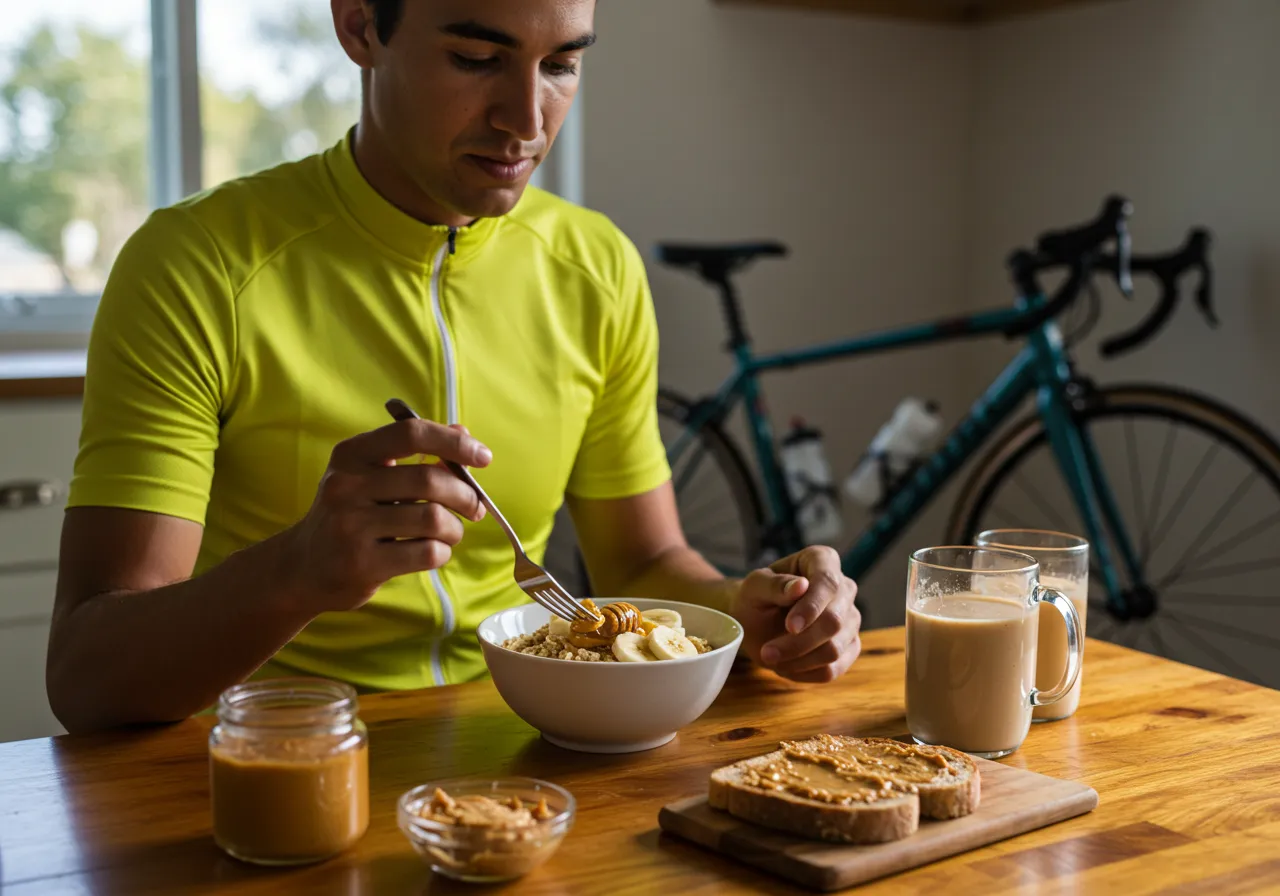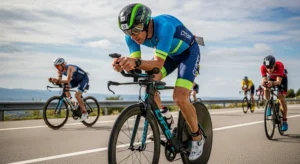Proper nutrition is essential for cyclists aiming to achieve peak performance. By fueling the body correctly, you can enhance endurance, speed, and overall cycling efficiency. Inadequate nutrition can lead to fatigue, muscle cramps, and decreased performance, underscoring the importance of a well-planned diet tailored to your cycling needs.
This article covers key Cycling Nutrition Tips for Peak Performance:
Fueling Up Before the Ride
- Learn about the importance of starting with fully stocked glycogen stores and recommended pre-ride meals.
Staying Energized and Hydrated During the Ride
- Discover how to maintain steady energy levels and stay hydrated throughout your journey.
Recovering Effectively After the Ride
- Understand the role of post-ride nutrition in recovery and preparation for future rides.
Carbohydrates: The Cyclist’s Best Friend
- Explore different types of carbohydrates and their impact on performance.
Protein: Supporting Muscle Adaptations and Recovery
- Learn about high-quality protein sources and their benefits.
Healthy Fats: Fueling Endurance and Supporting Overall Health
- Find out why healthy fats are essential in your diet.
Micronutrients That Matter: Iron and Beyond
- Delve into crucial vitamins and minerals that support optimal performance.
Supplements: Do They Really Work?
- A critical look at popular supplements marketed towards cyclists.
Putting It All Together: Practical Nutrition Strategies for Cyclists
- Tips for creating a balanced meal plan aligned with your training schedule.
By following these tips, you can optimize your nutrition strategy, paving the way for improved cycling performance and reaching your peak potential.

1. Fueling Up Before the Ride
Starting any cycling session with full glycogen stores sets the stage for sustained energy and consistent performance. Glycogen, stored in your muscles and liver, is the primary fuel source your body taps into during moderate to high-intensity rides. Depleted reserves can lead to early fatigue, reduced power output, or even dreaded “bonking.”
Effective pre-ride nutrition focuses on carbohydrate-rich meals and snacks that are easy on digestion.
The timing and type of carbohydrates matter:
2–4 hours before riding
Opt for a balanced meal with both complex and simple carbs to ensure gradual energy release.
Examples: Oatmeal with honey and banana, whole-grain toast topped with peanut butter, rice paired with lean chicken, and pasta tossed in a light tomato sauce.
30–60 minutes before riding
Choose snacks that are quickly digestible, prioritizing fast-acting sugars.
Examples: Bananas with almond butter, fruit yogurt smoothies, and energy bars made with oats and dried fruit.
A cyclist’s best bet is to avoid heavy fats or too much fiber right before a ride, as these can cause stomach discomfort or sluggishness once on the bike.
Prioritizing pre-ride nutrition primes your body by topping off glycogen stores and ensuring readily available glucose in your bloodstream. With this foundation, you’re set up for steadier energy levels through even the toughest segments of your ride.
2. Staying Energized and Hydrated During the Ride
Maintaining energy levels during a ride is essential to prevent fatigue and optimize performance. Consuming carbohydrates consistently helps sustain your energy. Aim for an intake of 30-60 grams of carbohydrates per hour for rides longer than 90 minutes. For ultra-endurance events, this can increase to 60-90 grams per hour.
Effective Energy Sources
Effective energy sources include:
- Energy gels/chews
- Electrolyte drinks (e.g., Gatorade)
- Dried fruits like dates or raisins
- Rice cakes
- Oat bars
- Peanut butter & jelly sandwiches
Hydration plays a crucial role in endurance sports. Proper hydration strategies can significantly impact your performance and overall experience during long rides. You should drink approximately 500ml before starting your ride and continue hydrating with 500-750ml per hour while cycling. Understanding your hydration needs is vital for optimal performance.
Key Practices for Staying Hydrated
Key practices for staying hydrated include:
- Using sports drinks: These provide both fluids and electrolytes.
- Carrying electrolyte tablets: Useful for replenishing lost minerals.
- Alternatives like coconut water: These are natural options to maintain electrolyte balance.
Staying properly hydrated ensures that your body can efficiently regulate temperature, transport nutrients to muscles, and remove waste products, thereby supporting peak performance throughout your ride.
3. Recovering Effectively After the Ride
Post-ride recovery is crucial for facilitating muscle repair and preparing your body for future rides. Proper nutrition immediately after a ride can accelerate recovery, helping you maintain peak performance.
Key nutrients to focus on during the recovery phase include:
- Carbohydrates: Essential for glycogen replenishment, which restores energy levels depleted during the ride. Aim to consume around 60-80 grams of carbs within 30 to 45 minutes post-ride. Excellent sources are pasta, cereal with milk, or a banana smoothie.
- Protein: Vital for muscle repair and growth. Consuming 20-30 grams of protein post-ride can aid in reducing exercise-induced inflammation and promote faster recovery. Consider options like grilled chicken with quinoa, scrambled eggs with whole-wheat toast, or a protein shake.
Combining both carbohydrates and protein in your post-ride meal ensures that you address both glycogen stores and muscle repair needs. For instance, a smoothie made with banana and protein powder offers a balanced option that’s easy to digest.
Additionally, rehydration is critical. Drink plenty of water or an electrolyte-rich beverage to replace fluids lost through sweat. Nutrient-dense supplementation, such as BCAAs (branched-chain amino acids), can also help reduce muscle soreness, while omega-3 fish oils support joint health.
By prioritizing these nutritional strategies, you set the foundation for optimal recovery and sustained cycling performance.

4. Carbohydrates: The Cyclist’s Best Friend
Carbohydrates for cyclists are the main source of fuel, directly affecting energy levels and endurance during both training and competition. Not all carbs are the same—knowing the different types can help you perform better.
Types of Carbohydrates
Simple Carbohydrates
These include sugars found in foods like honey, bananas, sports gels, and white bread. Simple carbs digest quickly, providing a rapid energy boost—ideal for short, intense efforts or when you need quick fuel during a ride.
Complex Carbohydrates
Sources include oatmeal, brown rice, whole-grain pasta, and sweet potatoes. Complex carbs break down more slowly, supplying steady energy over longer periods. For endurance rides or races lasting several hours, these slow-digesting options help preserve glycogen stores and prevent energy crashes.
Oatmeal with a sprinkle of cinnamon is a favorite among endurance cyclists for its combination of slow-release energy and blood sugar control.
Strategic Carb Choices
- Pre-ride: Opt for complex carbs such as whole-grain toast or pasta to start with full glycogen tanks.
- During rides: Rely on simple carbs like energy chews or ripe fruit for fast energy.
- Natural options: Bananas and honey deliver both quick sugars and anti-inflammatory benefits without the artificial additives found in some commercial products.
Cyclists who tailor their carb sources to match ride intensity and duration experience fewer bonks and sustain optimal power output throughout the session.
5. Protein: Supporting Muscle Adaptations and Recovery
Protein intake for cyclists plays a crucial role in enhancing muscle adaptations to training and promoting faster recovery between rides. As you engage in strenuous cycling activities, your muscles undergo continuous stress and micro-tears. Adequate protein consumption helps repair these damages and allows your muscles to grow stronger, improving overall performance.
Sources of High-Quality Protein:
- Lean Meats: Chicken, turkey, and lean cuts of beef provide essential amino acids necessary for muscle repair.
- Dairy Products: Greek yogurt, cottage cheese, and milk offer both protein and calcium, aiding muscle function and bone strength.
- Plant-Based Options: Legumes such as lentils and chickpeas, tofu, and quinoa are excellent sources for vegetarians or those looking to diversify their diet.
Incorporating these protein sources into your meals can significantly aid in muscle recovery post-ride. For example, consider adding a grilled chicken breast to your salad or blending a scoop of whey protein with soy milk in your post-ride smoothie. Balancing your protein intake not only supports muscle repair but also enhances the body’s ability to adapt to increased training demands over time.
6. Healthy Fats: Fueling Endurance and Supporting Overall Health
Dietary fat often gets overshadowed by the focus on carbohydrates and protein, yet healthy fats for cyclists play a crucial role in cycling nutrition tips for peak performance. Fat is a dense energy source, providing more than double the calories per gram compared to carbs or protein. During longer rides, especially when glycogen stores start to dwindle, your body relies increasingly on fat for sustained energy.
Key benefits of including healthy fats in a cyclist’s diet:
- Long-lasting energy: Unlike quick-burning carbs, fats break down slowly, offering a steady fuel supply during endurance events. This helps delay fatigue and supports consistent effort over extended periods.
- Nutrient absorption: Many essential vitamins (A, D, E, K) are fat-soluble. Consuming fats like avocado or olive oil alongside fruits and vegetables boosts nutrient absorption and utilization.
- Inflammation control: Fats from sources such as salmon, walnuts, chia seeds, and flaxseed oil contain omega-3 fatty acids known to reduce exercise-induced inflammation and support joint health.
- Cellular function: Fats are vital for hormone production and cell membrane integrity—both essential for recovery and adaptation.
Smart choices for cyclists include:
- Avocado
- Extra virgin olive oil
- Oily fish (salmon, sardines)
- Nuts (almonds, walnuts)
- Seeds (chia, flax)
Balancing these fats within your meal plan ensures you’re not only fueling for performance but also supporting overall well-being on and off the bike.
7. Micronutrients That Matter: Iron and Beyond
Proper intake of micronutrients for cyclists is crucial for achieving peak performance and maintaining overall health. Vitamins and minerals play specific roles in the body’s energy production, muscle function, and recovery processes. Deficiencies in these essential nutrients can significantly hinder your cycling progress.
Iron: The Oxygen Carrier
Iron is particularly important for cyclists. It helps in the production of hemoglobin, which is responsible for transporting oxygen to your muscles. Low iron levels can lead to fatigue, diminished endurance, and impaired performance.
Foods rich in iron include:
- Lean red meats
- Spinach
- Lentils
- Fortified cereals
Calcium and Vitamin D: The Bone Protectors
Calcium and Vitamin D are vital for bone health. Cycling, being a high-impact sport, increases the risk of bone injuries if calcium intake is insufficient. Sources include dairy products like milk, cheese, yogurt, and leafy greens such as kale and broccoli.
Magnesium: The Muscle Supporter
Magnesium supports muscle function and energy production. A deficiency can lead to muscle cramps and weakness. Magnesium-rich foods include nuts, seeds, whole grains, and dark chocolate.
B Vitamins: The Energy Boosters
B Vitamins (B6, B12) aid in energy metabolism by converting food into usable energy. They also support red blood cell production, which is critical for oxygen transport during intense rides. Sources include eggs, poultry, fish, whole grains, and legumes.
To ensure you’re getting these essential micronutrients:
- Incorporate a variety of colorful fruits and vegetables into your diet.
- Consider a daily multivitamin if you have any dietary restrictions.
- Consult with a nutritionist to tailor a plan that meets your specific needs as a cyclist.
Maintaining an adequate intake of these vitamins and minerals will support your overall performance and help prevent deficiencies that could impact your training regimen.
8. Supplements: Do They Really Work?
Supplements for cyclists often come with big promises, but not every product delivers measurable benefits.
Here’s what you need to know about some of the most popular options:
Branched-Chain Amino Acids (BCAAs)
BCAAs are marketed for reducing muscle soreness and promoting recovery. Some cyclists report less post-ride fatigue when using BCAA powders or capsules, especially during intensive training blocks. Scientific evidence is mixed, with studies showing slight reductions in muscle damage but limited impact on actual performance gains if protein intake is already sufficient.
Tart Cherry Juice
Tart cherry juice stands out for its anti-inflammatory and antioxidant properties. Endurance athletes use it to speed up recovery by decreasing muscle soreness and oxidative stress after long rides or races. Drinking 60–90ml of concentrated tart cherry juice daily—starting a few days before a demanding event—can help reduce delayed onset muscle soreness (DOMS).
Omega-3 Fish Oils
Omega-3 fatty acids support joint health, decrease exercise-induced inflammation, and may aid heart health—crucial for cyclists with high training volumes. Regular supplementation (1–2g per day) from fish oil capsules or plant-based alternatives like algae oil can help athletes who don’t consume oily fish regularly.
While some supplements provide real value, others offer marginal returns if your diet is already balanced and nutrient-rich. Always check for third-party testing to avoid contamination and banned substances.
Cyclists aiming for peak performance should start by focusing on whole-food nutrition before considering supplements as an adjunct tool. Balanced fueling strategies remain the foundation of sustainable progress.
9. Putting It All Together: Practical Nutrition Strategies for Cyclists
Nutrition planning strategies for cyclists start with a clear understanding of your training load, race calendar, and personal preferences. Creating a balanced meal plan isn’t about rigid rules—it’s about flexibility and consistency.
Here’s how you can put these cycling nutrition tips for peak performance into action:
Building Your Meal Plan
- Match intake to training: On high-intensity or long training days, increase carbohydrate portions—think oatmeal with honey and bananas for breakfast, rice or pasta at lunch, and quick carb snacks pre-ride.
- Include protein in every meal: Support muscle recovery with eggs at breakfast, lean meats or tofu at lunch, and a post-ride smoothie with whey protein.
- Don’t neglect healthy fats: Add avocado to salads, use olive oil in cooking, and enjoy nuts as snacks to fuel endurance.
- Micronutrients matter: Rotate iron-rich foods like beef or spinach and include colorful vegetables to cover vitamin needs.
Fueling During Long Rides
- Set carb goals: For rides over 90 minutes, aim for 30–60g carbs per hour using energy gels, dried fruit, or oat bars.
- Hydration strategy: Drink before you’re thirsty—consume small amounts (500–750ml per hour) and rotate in electrolyte drinks.
- Practice your plan: Test foods and timing during training, not just on race day.
Consistency in nutrition habits leads to reliability on the bike. The right plan keeps energy steady, recovery swift, and performance at its peak.




